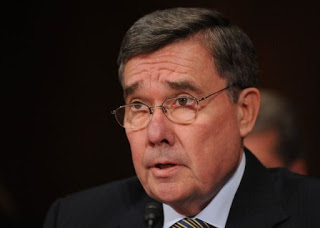Editor’s Note: More tax dollars going to another foolish war that is impossible to win.
 |
| Gil Kerlikowske, director of National Drug Control Policy © AFP Jewel Samad |
WASHINGTON (AFP) – The United States is launching a broad new strategy that would funnel several hundred million dollars for drug interdiction in Latin America, a senior US official told lawmakers Thursday.
The strategy aims to put in place “interlocking plans” in the region, notably in Mexico, Colombia and Central America, and expanding efforts in areas like the Caribbean to neutralize transnational criminal groups.
“We expect this Western Hemisphere Counterdrug Strategy to be completed this summer,” national drug control policy director Gil Kerlikowske told a Senate hearing.
“The global nature of the drug threat requires a strategic response that is also global in scope. It is not realistic for countries to expect to be effective if they are operating in a vacuum,” he added.
The strategy will merge a handful of existing programs, including Plan Colombia, which has received more than $6 billion in US aid since it was launched in 2000, and the Merida Initiative for Mexico, for which Congress has appropriated $1.5 billion since 2008.
The United States is the final destination for massive amounts of drugs — cocaine, heroin, marijuana and methamphetamines — produced in or trafficked through South and Central America.
With battles for control over lucrative smuggling routes and crackdowns by governments, the drug trade has led to several thousand people being killed in recent years, notably in Mexico.
Much of the new US strategy will focus on interdiction and disruption of transnational criminal elements, as well as strengthening institutions, reducing demand for drugs and developing community policing and other local counter-drug efforts.
William Brownfield, assistant secretary of state for counter-narcotics and law enforcement, said the United States was facing “complex and evolving threats” from crime syndicates, violent youth gangs and foreign terrorist groups in the region, and that “illegal narcotics remain the financial lifeblood of these organizations.”
Brownfield told the Senate panel that Central America was now facing “the most emergent threat in the hemisphere,” as syndicates move deeper into the region to take advantage of weak institutions and “a climate of impunity for criminal activity.”
He said Washington plans to spend some $200 million on the Central American Regional Security Initiative, or CARSI, which was launched in 2008.
But “progress in Central America will only push drug traffickers elsewhere if we do not support strong institutions throughout the hemisphere,” Brownfield said.
Washington is therefore focusing on a Caribbean Basin Security Initiative, aimed at beating back organized crime and trafficking, improving police forces and strengthening institutions and civil groups, Kerlikowske said.
US president Richard Nixon declared a war on drugs in 1971, and the program was expanded dramatically into Latin America in the 1980s.
Kerlikowske insists interdiction efforts have worked, citing cocaine production in Colombia which plunged by 60 percent from a high point in 2001 to 2009.
Cocaine production in the Andean region as a whole has dropped by 34 percent since 2001, he said, resulting in dramatically higher street prices and lower purity levels for the drug.
© AFP — Published at Activist Post with license
linkwithin_text=’Related Articles:’

Be the first to comment on "US broadens LatAm drug strategy"